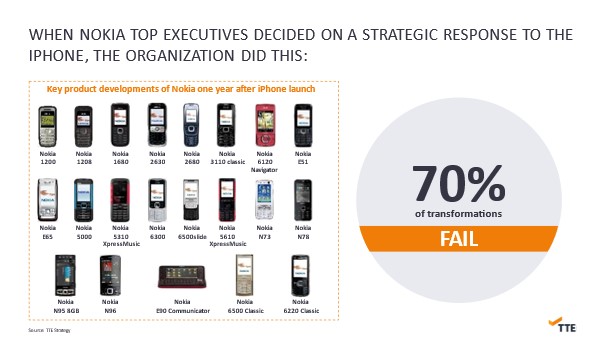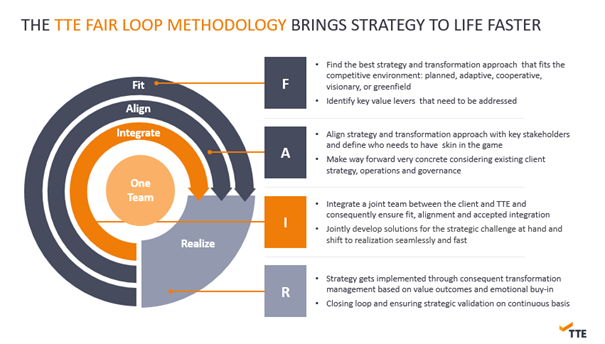
One year after the iPhone launch in 2007, Nokia’s top management strategy was to respond strongly to the iPhone, and senior management gave instructions to the organization accordingly. The strategy was clear: bring a phone to the market that has what people love about the iPhone – a touch screen, a simple and clean design, and an operating system that was intuitive and flexible to handle. In 2008 and subsequent years, Nokia’s development teams still offered a large range of phones, and the phone business strategy failed, as we all know.

If you search for how many strategy implementations fail, you will find numbers consistently around 70% over the past decades with not much positive development – consequently, implementation and transformation is extremely expensive to organizations or can even put a company at risk overall.
From my perspective when discussing with clients and strategy professionals, the main reasons are often obvious ones:
For #1, approaching the content development of your strategy in the right way is an art in itself – different strategic complexities apply depending on the answers to three core questions that need to be addressed in the very beginning:
At TTE, we have been working on different strategy challenges together with our clients depending on the answers to the above questions – either a very classic planning style or fast and rigorous adaptation to new realities.
For #2, a mix of measures needs to apply. Setting up the right team, with people who understand the business and experts in strategy and transformation, but also ensuring that a strategy is implementable from an overall resourcing perspective – without that, your strategy remains a daydream. Regarding the process of strategy development and implementation, the aspect of future shadowing is key: those who need to make it all happen later need to sit at the table very early on. These key people need to own the process and plan; they need to engage, explain, and execute accordingly. Oftentimes, that’s not straightforward, as uncertainties and personal fears occur (see also #3) – working together with an outside party that can act as a container to hold it all together can make a real difference. It can provide certainty and a mirror to actually stay on course – or to adjust if adaption is required.
For #3, bringing strategy to life at the end of the day is all about transforming how people work in an organization, but also how customers or other stakeholders interact. They all need to be on board. In our experience, that is where strategy hits reality at its best (or worst). Empirical research has proven that involving stakeholders very early on makes this much more likely to succeed – applying a fair process that ensures everyone is engaged and expectations are clear is a secret ingredient to successful strategy implementation.
In order to apply these aspects, TTE Strategy is employing its unique TTE FAIR LOOP methodology that brings strategy to life faster than a conventional approach.
The TTE FAIR LOOP is based on the core belief that one team drives strategy and transformation from the start, ensuring the right strategic fit leveraging the most suitable value levers. It is aligned with key stakeholders so that they have skin in the game, but also builds on the existing company strategy to leverage all the good that’s there. It integrates strategy and transformation for acceptance leveraging the fair process methodology – with TTE and our clients working hand in hand as one team. The loop seamlessly transitions into realization, with continuous strategic validation.

Strategy development needs to be an integrated strategy and transformation loop – the times of annual strategy processes are over in many industries as the world is moving at a fast pace. Truly adopting strategic ideas will be the only criterion that matters to the leaders of tomorrow, and staying on course means TTE Strategy supporting organizations in defining their strategic pathway and jointly finding the most suitable way to get traction.


TTE Strategy